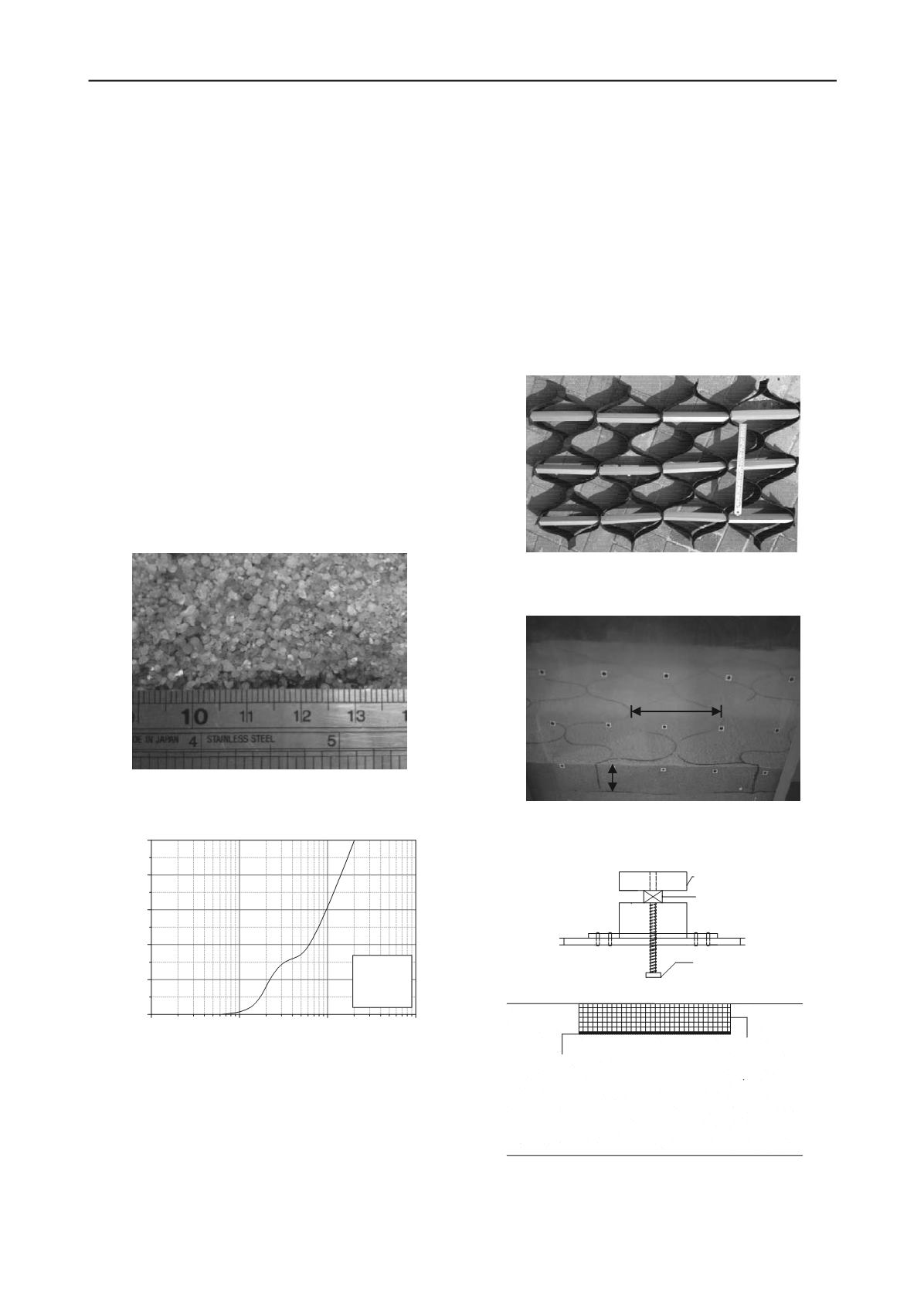
986
Proceedings of the 18
th
International Conference on Soil Mechanics and Geotechnical Engineering, Paris 2013
a situation that the ground is nearly immersed by water because
of intense rainfall. The model tests were carried out with a
sandbox fabricated in-house, which was deisgned at 1,670 mm
in length, 550 mm in width, and 1,300 mm in height. In
addition, the sandbox is perfectly sealed, preventing the water
from draining out during testing. Therefore, a desired condition
that the ground is excessively and rapidly saturated by heavy
rainfall could be best simulated. In addition, for a better
modeling of the unreinforced natural ground, the model was
prepared at a loose to moderate condition with the unit weight
around 19.6 kN/m
3
, corresponding to a relative desntiy around
40% at 20% water content.
The sandy soil used in the model tests is the so-called China
Standard ISO sand (Figure 1). The specific gravity of this soil is
2.65, with the maximum and minimum dry densities equal to
1.91 g/cm
3
and 1.62 g/cm
3
, respectively. With our in-house
triaxial tests, the angle of internal friction is around 38 degrees
at a relative density of 70%.
Figure 2 shows the grain size distribution of this sand. It is
worth noting that although the soil is also categorized into a SP
(i.e., poorly graded sand) type of soil according to the Unified
Soil Classification System, its size is not particularly uniform
with some presence of small to large sand particles (see Figure
1)
, compared to the “popular” sand
, such as the Toyuora sand or
Nevada sand.
Figure 1. The China Standard ISO sand.
0.01
0.1
1
10
0
20
40
60
80
100
Cumulative percent finer (%)
Grain size (mm)
D
10
=0.18mm
D
30
=0.30mm
D
50
=0.83mm
D
60
=0.99mm
Figure 2. Grain size distribution of the China Standard ISO
sand.
Figure 3 shows the appearance of geocell used in this study,
which is manufactured by Beijing Orient Science & Technology
Development Co., Ltd. (BOSTD) in China. The pocket size of
the geocell is rather comparable to most commercial geocells in
around 200 mm x 200 mm (Wang, 2007). Note that the geocell
sample, courtesy of the manufacturer, is of no perforated holes
on it. Also note that the 75-mm-high geocell sample is
specifically adopted in this study, for a better fit to the
dimension of the experimental layouts.
Figure 4 shows the installation of geocell during model
preparation. The instrumentation includes LVDTs to measure
the ground settlement and heave, and the particle image
velocimetry (PIV) technique (White et al. 2003) to analyze the
soil displacement in the ground subject to strip loading.
Figure 5 shows the schematic diagram of the experiment
layout. With the footing
’s width
in 100 mm, the ratio between
the footing width to the geocell pocket size is around 0.5, close
to the optimum ratio suggested in a related study (Dash et al.
2001b). Note that a layer of geotextile was installed between the
geocell mattress and the foundation for preventing the wash-
away of sand infills from the pocket. A total of three tests, two
with geocell reinforcement and one without reinforcement, are
reported in the following.
Figure 3. Top view of geocell mattress after expanding.
Figure 4. Installation of geocell in the soil model.
Loading strip
Load cell
Hydraulic cylinder
B=100mm
Geocell mattress
Geotextile
Figure 5. The schematic diagram of the experiment layout.
Pocket size = 200 mm
Geocell height = 75 mm
Foundation constructed by the
China Standard ISO Sand, in 40%
relative density and 20% water
content


